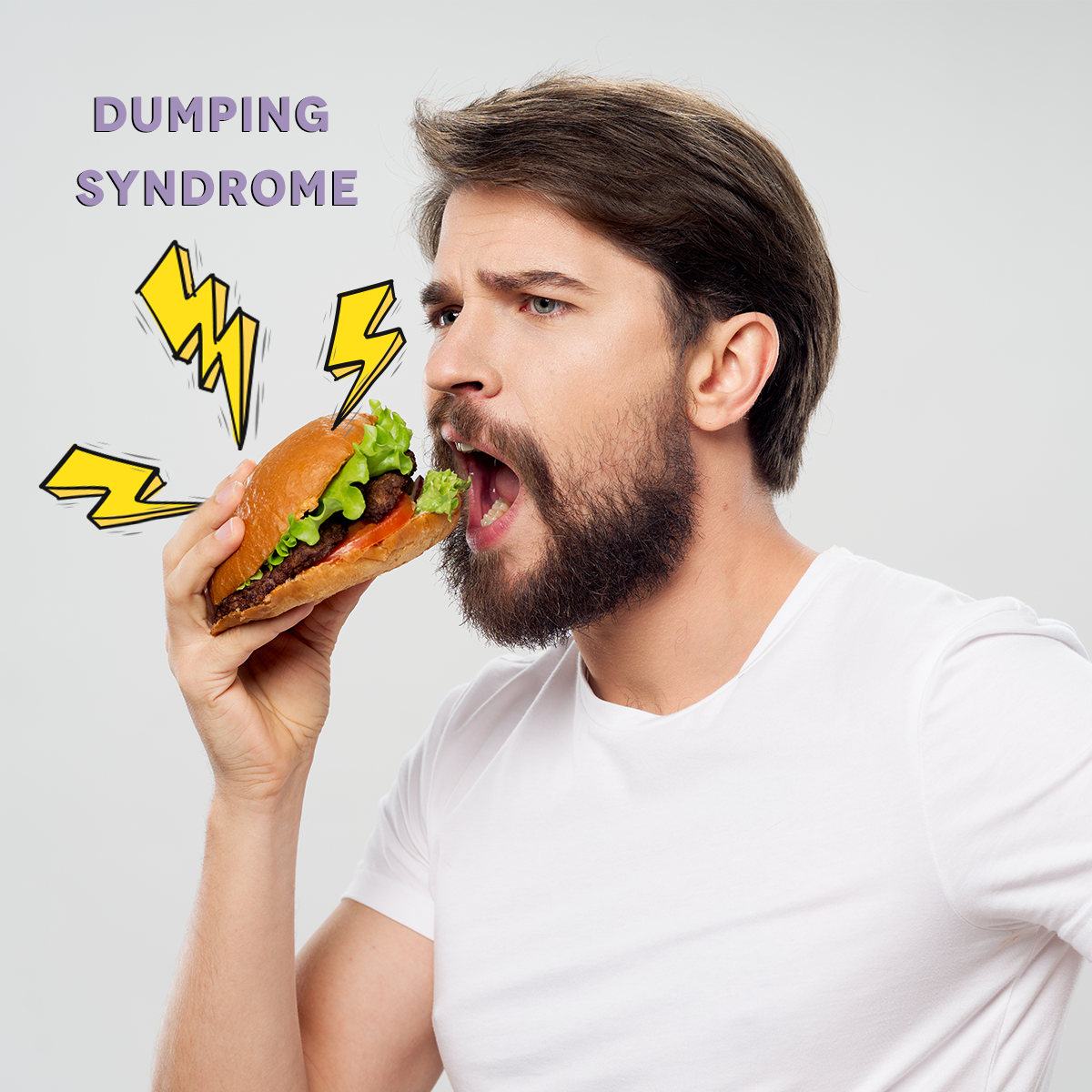What is Dumping Syndrome?


While weight loss surgery is advised for many people with a BMI over 35, there can be complications. One of these is a condition known as Dumping Syndrome, although this type of surgery isn’t the only cause of this common issue.
In this article, we will take a look at Dumping syndrome, discuss the causes and symptoms, and give advice on what to do if diagnosed with the condition.
What Is Dumping Syndrome?
Dumping syndrome is a condition that can sometimes develop after a patient has had surgery with alterations of their gastro-intestinal tract.
Dumping syndrome (also known as rapid gastric emptying), occurs when food moves from the stomach into the small bowel too quickly, and this can cause side effects, such as diarrhea, feelings of nausea, and abdominal cramps.
Symptoms of dumping syndrome can occur 10-30 minutes after eating, although some people can experience symptoms between 1-3 hours after having something to eat. There are also people who can experience both early and late symptoms.
Thankfully, the condition can be treated through diet and lifestyle changes, although in more serious cases of dumping syndrome, medication or further surgery may be needed.


The Causes Of Dumping Syndrome
The following types of surgery can increase the risk of dumping syndrome.
Gastrectomy – The removal of some or all of the stomach. This type of surgery is usually carried out on patients with stomach cancer.
Esophagectomy – A surgical procedure where some or all of the food pipe is removed and then reconstructed with another body part. This type of surgery is usually used to treat advanced esophageal cancer.
Gastric Bypass Surgery – This type of surgery creates a small pouch in the stomach to limit the patient’s food intake. It is usually performed to treat life-threatening obesity.
Due to the changes in the stomach after surgery, food and gastric juices can move from the stomach to the small intestine in a fast and uncontrolled manner. While some people can experience the symptoms of dumping syndrome shortly after surgery, there are others who may experience symptoms years after the surgical procedure has taken place.
The Symptoms Of Dumping Syndrome
The symptoms will vary on the individual and the phase of the condition. Symptoms can be quick to come on after eating, especially when sugary food items have been consumed, although some may experience symptoms up to 3 hours later.
Symptoms of early dumping syndrome
These can include:
- feelings of dizziness
- feelings of being bloated
- diarrhea
- feelings of nausea
- rapid heart rate
- skin flushing
- vomiting
- abdominal cramps
Symptoms of late dumping syndrome
These can occur within 3 hours after eating. They can include:
- feelings of dizziness
- rapid heart rate
- skin flushing
- fatigue and weakness
- feelings of hunger
- sweating
Why symptoms happen
Symptoms happen because the small intestine struggles to absorb the nutrients from the foods that haven’t had time to fully digest in the stomach.
In the case of early dumping syndrome, discomfort can arise because of the rapid movement of fluid into the intestine. And with late dumping syndrome, symptoms can arise because of low blood sugar. This is because the body has to release a large amount of insulin to help the body absorb the sugars released by the food.


Bariatric Surgeon | Gabriela Rodriguez, MD FACS
How Is Dumping Syndrome Diagnosed?
When a patient detects any of the symptoms associated with dumping syndrome, they should visit their doctor for advice and further investigation.
When diagnosing dumping syndrome, the doctor will usually carry out the following.
A medical history. The doctor will carry out a full medical and family history to assess the signs of dumping syndrome. Some doctors use a scoring system when assessing each symptom, and this will help them make the correct diagnosis.
A gastric emptying scan. The patient will be given food containing a very small level of radioactive material, and this will be tracked through the digestive system with a scanner. The quicker the food moves, the higher the likelihood of dumping syndrome.
An oral glucose tolerance test. This test is used to check for the low levels of blood sugar that are associated with late dumping syndrome. The patient will be given a sugary drink, and blood tests will then be taken.
Tests may be taken to check for any other health conditions related to the symptoms. Such conditions can include stomach ulcers and inflammation of the stomach lining.
If dumping syndrome is diagnosed, a number of treatment options will be advised.
Treating Dumping Syndrome
Changes to the patients’ diet can often treat dumping syndrome, but in more severe cases, they might require medication and surgery.
Dietary changes
In some cases, dietary changes may be enough to relieve the symptoms of dumping syndrome. The patient may be encouraged to eat several small meals throughout the day instead of three larger meals. They might be encouraged to eat a high fiber diet, with foods such as oatmeal, beans, lentils, and wholemeal bread. And they will be asked to avoid foods and drinks that are high in sugar, such as cakes, candies, fizzy sodas, and some fruit juices.
The patient might also be asked to cut out alcohol from their diet, as well as dairy foods. They might also be asked to increase their protein intake. Such changes can be assessed on how well they relieve the symptoms of dumping syndrome and will be encouraged into the future if they prove successful.
Medication and surgery
If dietary changes don’t improve the symptoms of dumping syndrome, the doctor might prescribe medications. More commonly, an octreotide injection will be prescribed, as this is an anti-diarrhea drug that can slow the rate at which the stomach empties. It also prevents the release of insulin. The doctor might also prescribe acarbose, which is an injected drug that can slow the rate at which the body absorbs carbohydrates.
If medication doesn’t work, surgery may be recommended. The type of surgery will depend on the cause of dumping syndrome.
Contact Us
If you’re in need of weight loss surgery, don’t let dumping syndrome deter you from surgery. However, if you would like to know more about the procedure, or if you are experiencing the symptoms of dumping syndrome after surgery, get in touch with us for professional advice.